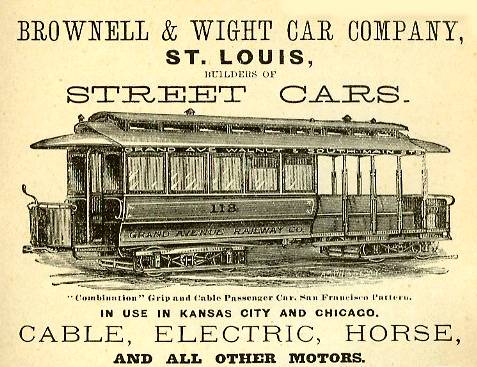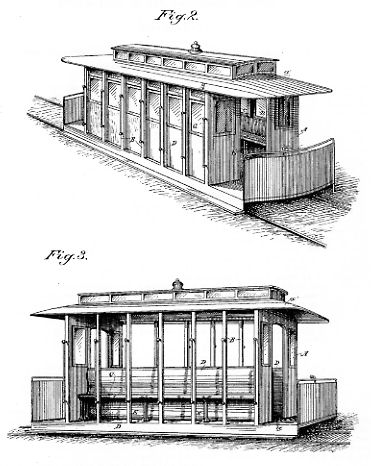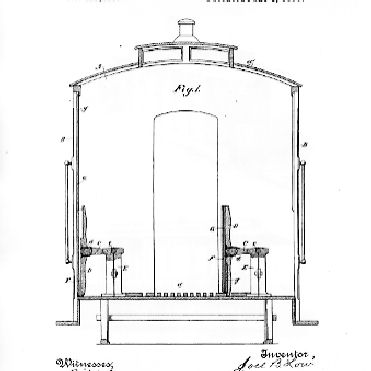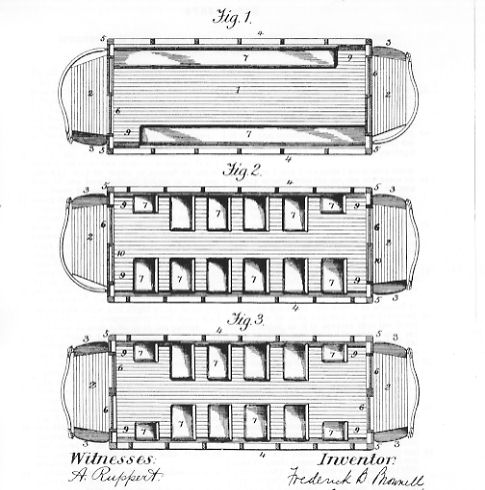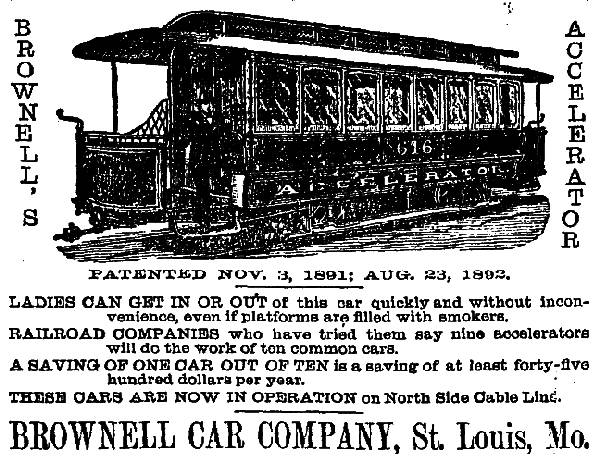The Brownell Car CompanyBrownell & Wight Car Company
The Brownell & Wight Car Company was established about 1875 by Frederick Brownell and Andrew Wight. Wight had established himself in the horse streetcar and carriage business at St. Louis about 1857. Eleven years later he had taken on as an apprentice 16-year-old Fred Brownell. Within two years Brownell had become foreman of the paint shop. The following year Wight became ill and in his absence young Brownell found himself managing the business. {177}
Wight’s ill health apparently persisted, and in 1875 the business was incorporated, with Wight holding 938 shares and Brownell 60. (Since this is 998 shares, one suspects someone else held two more.) Wight was President of the new corporation, and Brownell was Vice-President. But with Wight apparently too ill to do so, Brownell was the active manager. Wight died the following year and Brownell became President of the corporation. {177} It took Brownell several years to accumulate enough money, and/or to arrange financing, but in 1879 he bought out the Wight interests and renamed the corporation the Brownell Car Company. But Frederick Brownell was a conservative man to begin with, and as he got older, he got more conservative, and several St. Louis car builders were spawned by employees with new ideas leaving Brownell. Among these were the Laclede Car Company in 1883 and the St. Louis Car Company in 1887. Over the course of its lifetime, the Brownell Car Company produced streetcars powered first by horses, then by cable and finally by electricity. It produced cars for many cities, among which was Chicago, for whose extensive cable car lines it produced many cars. These were long double-truck combination open-closed cars. The two most notable products of the Brownell company were “Low’s Adjustable Car” and Brownell’s “Accelerator Car.” Low’s Adjustable Car— was a convertible car with an ingenious apparatus for changing from summer to winter operation, invented by Joel B. Low of San Francisco. It would be interesting to know just how Brownell came to build it, and just how practical it was in actual operation. In winter, the seats (T-shaped in cross section), together with their attached backs could be flipped outward, away from the aisle, so that the seat backs formed the outer wall of the car. (See the left side of Fig. 1, below, together with Fig. 2.) A sash stored within the seat back was then raised to fill the space between the seat back and the top of the car.
In summer the seats, together with their attached backs, could be flipped inward toward the aisle so that they faced outward. (See the right side of Fig. 1, above, together with Fig. 3.) In 1891, the North Clark Street cable line in Chicago was one of the first to try the car, though it was apparently available also as a self-powered electric car. It was said the conductor could make the conversion in as little as three minutes. {125} About the same time Chicago was trying out Mr. Low’s invention, George J. Sherman, H.N. Greene and Brian Philpot were incorporating the Low Adjustable Car Company in Illinois with capital stock of $1 million. {232} We have no idea at this time what became of this firm or whether its creation had any effect on Brownell’s further production of the Low cars. It is interesting though to note Mr. Low was not among the incorporators. Brownell’s “Accelerator Car”— was a patented design with seating and bulkhead door placement intended to “accelorate” the flow of traffic onto and off of the car. One factor in this was the use of larger platforms than had been used before. The accelerator car appears to have been based on two patents issued to Frederick Brownell: no. 462,620, dated 3 November 1891 and reissued 20 November 1892 as RE11,289, and no. 481,467, dated 23 August 1892.
The basic idea is really quite simple: instead of having the end door of a car centered in the end wall, it is offset toward the side of passenger flow. Further, rather than the usual hinged door, the door is a pocket door that slides back into the bulkhead (Figs. 1 and 2), or—in the case of varying sides for entry/egress—a set of by-pass doors (Fig. 3). As one can see from the drawing, seats are arranged so as to facilitate access to these doors.
The stock market crash of mid-1893 must have hit the car builders of the St. Louis area especially hard, as a big news item of late 1894 was the prospective unification of several car builders into a syndicate. This would have included the American Car Company, the Brownell Car Company, the Laclede Car Company, the St. Charles Car Company. and the St. Louis Car Company. Though the news reports indicate the process would make them “practically into one concern,” it appears the purpose of the “syndicate” was really to issue bonds that could be sold in England to provide working capital to keep these concerns afloat at a time when railroads had no money to order cars. We have so far been unable to determine whether these plans were realized financially. Certainly they had no reality insofar as the management of the individual companies was concerned. {175} As a matter of fact, only three years later, with the lingering effects of the depression, Brownell was forced to file a deed of trust for the benefit of more than 100 creditors to whom it owed in excess of $200,000. The deed covered everything owned by the company, including 150 feet of ground on Monroe Street and 14 other pieces of property. Creditors included four banks and three individuals. {176} Brownell was able to hang on, but only for awhile longer. Always short on capital, and limited by Frederick Brownell’s adherence to tried-and-true (but by now outmoded) car designs, in 1900 the Brownell Car Company was taken over by the American Car Company, another St. Louis street car builder established Yet Brownell somehow found the money to go on. But not for long. In 1902, it was bought out, some say by the American Car Company, while others say by the J.G. Brill Company. But it really doesn’t matter, since the American Car Company was itself bought out that same year by the J.G. Brill Company. Cast of Characters —Frederick B. Brownell (1851-1906+) was born at Troy, New York. He was educated there and came to St. Louis at the age of 16. There he completed a four-year apprenticeship in the carriage shop of Andrew Wight, and—due to Wight’s continued ill health—found himself at the ripe old age of 20 found himself in charge of the business. And by age 28 he owned the business. Brownell was an excellent craftsman, but as he got older, he got “set in his ways” and not interested in trying out any new ideas. He even went so far as to turn down orders for cars that didn’t meet with his ideas of good car design. He was constantly at odds with his senior employees, and several St. Louis car building firms were born out of Brownell employee frustration. Among these were the Laclede Car Company and the St. Louis Car Company. Andrew Wight (c1829-1876) was born in Connecticut. He was employed for some time as an ornamental painter by the John Stephenson Car Company in New York City where he gained some fame in the field of decorative art. Then he went west to work in the Chicago & Alton Railroad shops in Bloomington, Illinois. Among his assignments was the decoration of the C&A ticket office in St. Louis. In the mid-1850s, he quit the railroad job and relocated to St. Louis, where he went into business with Daniel R. Hart, a skilled mechanic, building, painting and repairing omnibuses. This business was incorporated in 1875 as the Andrew Wight Company, most likely to ensure the continuation of the business in the face of Wight’s lingering illness and to give his protégé Frederick Brownell a measure of ownership. |
